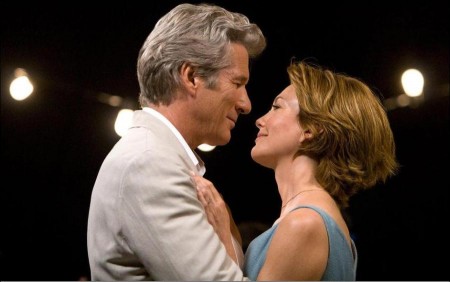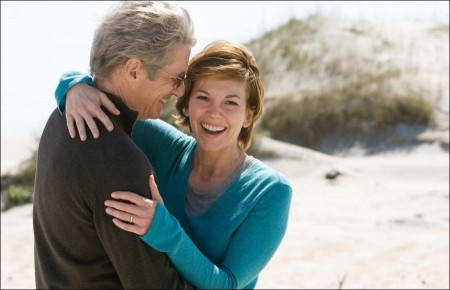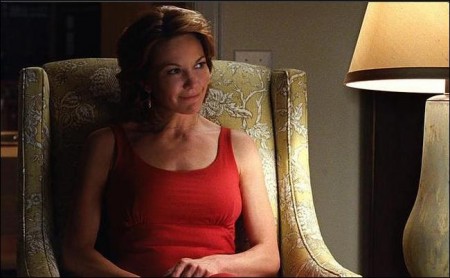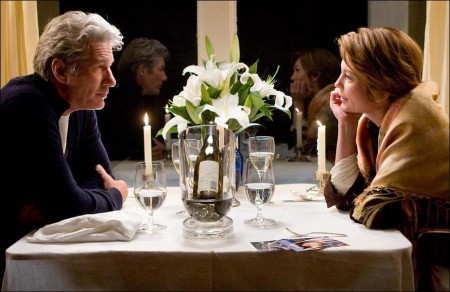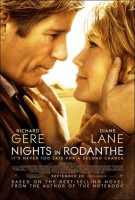Tagline: It’s never too late for a second chance.
A woman retreats to the tiny coastal town of Rodanthe, to tend to a friend’s inn for the weekend. Almost as soon as she gets to Rodanthe, a major storm is forecast and Dr. Flanner arrives. He is the only guest at the inn and now with the storm closing in, the two turn to each other for comfort.
Adrienne Willis (Diane Lane), a woman with her life in chaos, retreats to the tiny coastal town of Rodanthe, in the Outer Banks of North Carolina, to tend to a friend’s inn for the weekend. Here she hopes to find the tranquility she so desperately needs to rethink the conflicts surrounding her–a wayward husband who has asked to come home, and a teenaged daughter who resents her every decision.
Almost as soon as Adrienne gets to Rodanthe, a major storm is forecast and Dr. Paul Flanner (Richard Gere) arrives. The only guest at the inn, Flanner is not on a weekend escape but rather is there to face his own crisis of conscience. Now, with the storm closing in, the two turn to each other for comfort and, in one magical weekend, set in motion a life-changing romance that will resonate throughout the rest of their lives.
Sometimes Life Offers A Second Chance
“This is a story about people discovering there is an Act Two in their lives,” says director George C. Wolfe. It’s an apt theatrical reference that comes naturally to Wolfe, a renowned stage director, writer and producer with two Tony Awards to his credit, making his feature film directorial debut with “Nights in Rodanthe.”
“People go through a good portion of their lives making decisions and choices that are either good or bad, right or wrong, and they often feel that the state to which it brings them is permanent,” he says. “It’s as if they reach a certain point and say, `Okay, this is my life; this is what I made of it and this is all I get.’”
“But what happens as we embark upon the second half of our lives?” asks producer Denise Di Novi. “Do we find love? Do we find our soul mates if we haven’t found them yet, or if we found them and lost them? People are always discovering new interests and new facets of themselves. The idea of finding a soul mate in the middle of the journey is not so unusual; sometimes it takes that long and sometimes it happens when you least expect it. The dream of finding true love doesn’t end at 25. That’s the message of `Nights in Rodanthe’ and I believe many people can relate to that and will be inspired by it.”
“It’s a love story for adults,” offers Richard Gere, who stars as Paul. “These are people who had lives before they met and aren’t looking for a relationship to define them.”
Still, this is a relationship that will change how they define themselves and that, in turn, will alter the course of their lives well beyond the time they spend together. Says Wolfe, “Circumstances and dynamics evolve. Sometimes life and the universe offer us something we never expected or had given up hoping for.”
Not only does “Nights in Rodanthe” suggest that it’s never too late to find that one true connection, it is likewise never too late to regain the self you lost along the way, while living the life you thought you wanted-or that others expected of you. Above all, it is a sweeping love story in the Nicholas Sparks tradition.
Diane Lane, who stars as Adrienne, attributes Sparks’ appeal to “his sensitivity to people’s hearts. I think there is an appetite for seeing that other people are like us and have needs similar to our own, no matter the era, age or circumstances. Love crosses all lines.”
Sparks, the best-selling author of such memorable titles as The Notebook, Message in a Bottle and A Walk to Remember-the latter two produced for the screen by Di Novi- feels that Nights in Rodanthe is a thematic return to his origins as a storyteller. “It’s one of the most intrinsically romantic novels I’ve ever done. It has a storm, an isolated beach and a wounded couple who come together and heal each other, and it involves a whole range of human emotion: happiness, sadness, anger, frustration, passion, impatience and patience.”
“What I like about Nick’s work is that it gives equal weight to the male characters,” adds Di Novi, speaking as both a fan and creative collaborator, who believes that the emotional life of men is too often neglected or simplified in film and fiction. “Paul is a complicated man. He is not just `the guy Adrienne falls in love with.’ His experience is as important as hers and that’s an element of the story George and I strove to recreate on screen. It’s one of the reasons I wanted him to direct.
“I love George’s work,” she continues, citing Wolfe’s critically acclaimed direction of the HBO drama “Lackawanna Blues.” “His attention to detail in that piece, from the costumes and sets to just the overall richness of that whole world he created had such emotional impact. I knew he would bring that sensibility to this project.”
Another aspect the filmmakers responded to was the way in which Paul and Adrienne meet as independent, fully formed individuals people can relate to, with not only the requisite emotional baggage but with histories, opinions and responsibilities. Says Wolfe, “They have already experienced many things-the loss of parents, the birth of children, disappointments and pain that we all deal with.”
Paul, a surgeon, has come to the Outer Banks of Rodanthe to meet Robert Torrelson, the widower of a patient who accidentally died in his care. Ostensibly he is here to tie up loose ends and maybe circumvent a lawsuit, but there may be more compelling reasons driving him.
Says Gere, “Paul chose early on to put career first, to be the best doctor he could be, not for the money but genuinely to help people. And he has accomplished that, though, in the process, he is estranged from his adult son and has lost his marriage and his home. Now, facing this emotional and spiritual crisis, he walks away from all the former touchstones of his life. He arrives at the inn untethered.”
Adrienne arrives similarly untethered, although “undone” might be closer to the truth. While still coping with the fact that her husband has been seeing another woman, she is hit with the further disorienting news that he has changed his mind and wants her back. Clearly, this is what her two children want, in particular her daughter Amanda, who applies as much pressure as she can muster toward that end. Certainly it would be the simplest solution….but is it what Adrienne really wants?
“She’s in a 180-degree spin, first bracing for divorce, now a possible reconciliation. Adrienne has given up a lot of freedom over the years by putting her family first and she’s been comfortable with that, but lately she’s been honing a new identity for herself as a single woman and finds it’s not so easy to abandon that and go back,” says Lane. “I don’t think Adrienne sees herself as ripe for romance,” she adds. “That’s not at all where her mind is. She probably doesn’t see herself as ripe for anything right now except maybe three months in a spa.”
When Adrienne’s friend Jean goes on vacation and asks her to take over the duties of running the picturesque inn she owns on the Outer Banks one weekend, it’s a welcome retreat for Adrienne, an opportunity to sort things out. Simultaneously, it allows Paul a comfortable place from which to broach his difficult meeting with Torrelson.
The setting also offers Wolfe the opportunity to demonstrate what he feels is one of the story’s prominent themes: how the forces of nature can mirror the evolution of a relationship, and how an uncontrollable storm becomes a metaphor for the power of love. Thus, each of them arrives at the inn in what the director calls “a wonderfully vulnerable state. It’s as if life, faith and the elements unite to create the perfect opportunity. There, through a series of circumstances-dinners, conversations, confrontations and the ultimate intrusion of a hurricane that forces them to take refuge in the house and work together-they get to know each other in an honest and powerful way that is only possible when people are out of their element and removed from the artificial things that normally define them and keep them safe.”
Meeting Someone Can Change Your Course
“Talking with a stranger gives you permission to reveal yourself in a way that you rarely can with people you know,” Wolfe states. Being the focus of a stranger’s attention can prompt us to take a fresh look at ourselves and see, for the first time in years, strength we had forgotten or maybe longing and regret we had come to accept.
“What Paul stirs for Adrienne, and vice versa, is the audacity of `Who do you think you are?’ That’s a good question,” says Lane. “`Wait a minute while I think about that…who do I think I am?!’ That’s what people bring each other at the beginning of a relationship; the opportunity to say and do something intentional instead of just coloring by the numbers. It may be uncomfortable but it’s liberating.”
“In this way, Paul and Adrienne act as catalysts for each other’s self-realization,” offers screenwriter Ann Peacock. “Paul enables Adrienne to do what is right for her rather than what she had been conditioned to doing, and Adrienne enables Paul to drop his guard and open himself to the possibility of love and forgiveness.”
“It’s all a learning experience,” Gere suggests. “We’re all infants, trying to figure out who and what we are and what it all means. What’s beautiful about `Nights in Rodanthe’ is that it shows how two people in crisis can get past their defenses, reach out to each other and make enormous impact on each other in a relatively short period.” And that impact can often extend beyond the two of them.
Says Di Novi, “What they find with each other, the kind of connection they have, is one of those once-in-a-lifetime things, such a deep love that, as Adrienne says in the film, it makes you want to share it with the rest of the world.”
Richard Gere and Diane Lane Together Again
“Nights in Rodanthe” marks the third screen pairing of Richard Gere and Diane Lane. The two first met playing reckless lovers 24 years ago in Francis Ford Coppola’s “The Cotton Club,” and more recently portrayed a couple whose faltering marriage still radiates heat in the memorable 2002 drama “Unfaithful.”
Remarking on their palpable onscreen chemistry, Gere and Lane slip into an easy banter that proves the point even as they laugh about it. Lane cites the example of actors with sizzling real-life chemistry whose romantic scenes can fall inexplicably flat on film, before joking, “Richard and I have the opposite situation. We feel absolutely nothing standing next to each other…” at which point Gere jumps in to corroborate, “I mean nothing. Less than nothing. Yet, when you see it on screen it’s all there. It’s a miracle.” In truth, he goes on to say, “Our friendship has evolved over the years into a great sense of trust. I love working with her.”
Gere also believes that the differences between who they were in their “Cotton Club” days, both as actors and as individuals, and who they have since become, is appropriate to the kind of relationship that develops between Paul and Adrienne. “What was important to me in taking on this role, and Diane too, I believe, was that it wasn’t a story about kids who are goo-goo-eyed about each other from the moment they meet. It’s not that kind of movie. There are scenes in which they barely look at each other, but there is a powerful and deepening understanding at work and you can feel it evolve in front of you.”
Adds Lane, “What you potentially bring to a relationship at this stage is often so much more than what you had to offer at eighteen. You have more insight, more personality and more appreciation of things-and of each other.”
As all of these elements come together in the growing rapport between Paul and Adrienne, two people caught by a storm in the Outer Banks, “It never feels as though we are watching two actors. Rather, it’s as if we’re just watching two human beings experiencing life,” notes Wolfe.
Just as there is always a chance to fall in love and to find your purpose, there is always a chance to learn, to do things better and to make things right with the people in our lives. Beyond Paul and Adrienne are other key players in this drama, who support or challenge them in ways that help bring them to this juncture.
It is Torrelson’s tragedy that precipitates Paul’s journey to the Outer Banks and, subsequently, the opportunity for some serious soul-searching. It is Jack, Adrienne’s conflicted husband, who creates the crisis that sets her adrift. And it is Jean whose decision to entrust the inn to Adrienne this fateful weekend provides the perfect setting for storms to break and love to take hold.
Paul’s situation with Torrelson occurs almost simultaneously with the dissolution of his marriage and the deepening estrangement with his son, but, of the three, it’s the one problem that appears to have the simplest solution. Wolfe explains, “Paul is focused on his career crisis. A patient has died and her husband has filed a wrongful death suit. As is frequently the case with very focused, driven and accomplished people like Paul, he is not necessarily skilled at processing failure, loss or disappointment. He’s good at fixing things. He likes to leap over the complications and get to the result. So he has come to Rodanthe to fix this.”
Scott Glenn, who plays the grieving widower, says, “What Paul fails to understand is that Torrelson isn’t interested in money. It’s not about the lawsuit; he wants an apology. He wants to make sure that this person he loved, who died, was not just another number, that she was important and precious. The point, for him, is to get this doctor’s attention and hear him acknowledge that he screwed up and he’s sorry.”
“Scott is brilliant,” says Di Novi. “The scene in which Torrelson confronts Paul is just indescribably beautiful. This is a man deeply in pain, who has such a hard time expressing it. It’s clear that this is the first time Paul has been forced to connect with another human being in this way.”
While Paul struggles to make sense of this encounter and wonders how to approach his next challenge-mending the rift with his son-Adrienne is trying to decide how she feels about Jack, whose heartfelt pleas, even in this remote outpost, are as close as the telephone.
Christopher Meloni, who stars as Jack, sees his part as “the catalyst. Jack lights the fuse of what becomes Adrienne’s journey. He pushes her into this dilemma where she has to reconcile and examine everything to figure out what’s right or wrong for her and where she goes next.”
The role is more complex than would first appear. Di Novi points out, “No one sets out to be the bad guy. No one plans to do the wrong thing. There was a reason that Adrienne fell in love with Jack and we must understand there was a reason they were married for so long. It was essential that the actor who played Jack was able to bring out all these colors so he is not a black-and-white character.”
“He must be a worthy contender, so that you see Adrienne being genuinely and believably tugged back in his direction,” adds Wolfe.
Ultimately, says Meloni, “Jack is sincere in wanting to be part of the family again, but I don’t feel he’s coming back for the right reasons. Even through his sincerity you get the sense that there’s something not quite right about him, and, hopefully, audiences will pick up some of the misgivings Adrienne feels toward him, without necessarily even knowing why.”
One person who would likely agree is Adrienne’s loyal friend and confidant Jean, played by Viola Davis. Jean provides encouragement, humor and honest opinions … without waiting to be asked. Clearly, the two women go back a long way together, as Jean’s home, the inn, is full of crafts they made as girls, plus photos and mementos that share space with Jean’s travel souvenirs and the eclectic mix of art she has either made or collected through the years.
Says Di Novi, “Jean represents a completely liberated woman. She knows who she is and doesn’t care what people think. She gives full expression to her art and talent and lives life to the fullest, and in some ways that’s what Adrienne aspires to.”
Certainly Adrienne has those same elements in her nature, but, Davis observes, “While Jean pursued the dreams they likely both had as younger women, Adrienne is the one who suppressed some of that to raise children and lead a more stable, conservative life, forsaking certain freedoms and putting everyone else’s needs first. They’re a good match because they balance each other’s choices while sharing a similar point of view.”
Similarly, Jean’s freewheeling style is much different from the life Davis lives, which added to the challenge and fun of the role, and was part of the reason Wolfe cast her. “This is definitely not who I am,” she says. “Jean is much more flamboyant and free and would do things I would never do. I’m more grounded and introverted.”
Wolfe and Davis are both associated with the Public Theatre, but this the first time that they have collaborated so closely as director and actor. In casting her for “Rodanthe,” he was confident that “Viola could convey Jean’s warmth and playful vitality as well as the strong soul beneath, a woman who is fiercely protective of her best friend.”
Joining the main cast is Mae Whitman (“Arrested Development”) as Adrienne’s emotional and headstrong daughter Amanda, whose desire for her parents’ reconciliation weighs heavily on Adrienne; and Pablo Schreiber (“The Wire”) as Robert Torrelson’s son Charlie, who vents his grief fiercely when Paul comes to talk.
Stormy Weather
Production began in May 2007 in the small town of Rodanthe and its environs on the Outer Banks, an approximately 200-mile string of barrier islands that parallel the North Carolina coast and seasonally bear the brunt of the ocean’s fury. Known as the Graveyard of the Atlantic, this hurricane-prone region rates one of the highest densities of shipwrecks in the world.
“Nick’s books are always set in North Carolina and Rodanthe is an isolated and very specific part of the Outer Banks,” says Di Novi, confirming that the challenges of filming there were well worth the effort. “There is something undeniably magical about the place that we knew could not be duplicated anywhere else. It’s a setting rarely seen on film, a truly unique place in America that few people have experienced.”
Scouting locations for the film, Wolfe was particularly struck by the way the Outer Banks suits the story’s romantic drama. “It’s a landscape that’s breathtakingly beautiful, but also vulnerable and exposed, a relatively thin strand of earth surrounded by water on both sides. You can really feel the power of the ocean and the sky. It became clear to me how the forces of nature and the elements played a part in making this love happen between these two people.”
Screenwriter John Romano notes how Nicholas Sparks honors the storyteller’s tradition of harnessing these powerful external forces to his characters’ emotional states and the drama of their lives. “The hurricane rages outside, throwing them together, but there’s also a storm brewing within the house, between the two of them, that echoes it. There’s a seamless flow between the turbulence without and the turbulence within. It was George’s intention to see this realized on screen; in the way he imagined it-in the dialogue, in the way he shot it and in what the actors bring to it with their tremendous capacity for subtext.”
While it may be true that nature and circumstance conspire dramatically to bring Paul and Adrienne together, it is equally true that these forces seemed determined to scatter the crew and their materials all over the coastline.
With a laugh, Wolfe vividly recalls, “There were times we began filming and the ocean said, `No, you won’t be doing that scene today because I’m coming up to take away a piece of your set.’ And it would. There was nothing we could do but adjust our schedule. It was a fascinating process, especially for me, as a person who’s lived in New York City for a thousand years, to go out there and find myself actively negotiating a relationship with nature just to get my work done.”
Despite careful planning to avoid storm season, production was slammed on its second day by a Nor’easter, with 55 mph winds and rain. It was the earliest storm to hit the area in the past 30 years, bringing with it the highest tides seen in more than a decade. “The tide washed most of the sand out from under the house,” says Oscar®-winning production designer Patrizia von Brandenstein (“Amadeus”), referring to the story’s primary exterior set-an existing local structure that became the movie’s inn-which not only lost up to four feet of sand from its foundation but also two flights of 18-foot steps, along with props and equipment that had been stored there. “It was still standing, but at a very precarious angle. With the loose sand washed away, we saw big bags of sand that had been placed under the house to stabilize it during a prior storm, plus newly exposed roots and stumps of Cyprus trees, probably centuries old, that appeared at the water’s edge, left over from a time when this area was a coastal forest.”
Under von Brandenstein’s guidance, the crew brought in several additional construction units from nearby Wilmington and worked over the next four days to rebuild. “The two sets of stairs that washed down the beach were found a couple of weeks later and dragged back,” she says. “In the spirit of recycling, we found a use for it in our other sets, and that was appropriate, in a way, to the story. I like the idea of salvage, of taking something that appears ruined and remaking it. You see it in the way that Adrienne carves driftwood into treasure boxes, and then in the way that she and Paul salvage and remake their lives.”
Interiors were filmed in a comfortable two-family dwelling in Topsail Island, about 40 miles outside Wilmington, converted into a larger space to accommodate the inn’s lounge, dining room and kitchen by the removal of a few walls.
For Wolfe, the inn itself became “an integral character in the story, a place with history and a soul, laden with the years and peoples’ lives, and a kind of home to spiritual forces.” Mindful of the region’s unique multicultural history and imagining a rich backstory for Jean and her ancestral home, he sought to work some of those elements into the inn’s décor with the myriad, spiritually-themed artwork of generations sharing space with Jean’s own creations and the collected treasures of her interests and explorations.
Another remnant of Rodanthe’s spiritual heritage became one of the inn’s most striking exterior details, its deep blue shutters-known locally, Wolfe discovered, as “haint blue” and likely dating back to a time when survivors of slave ship wrecks settled in the area, adding the influence of their cultures and religions to the indigenous population.
According to custom, people would paint the shutters of their homes blue to keep away the “haints”-or haunts. Though tales of supernatural visitation are long gone, the custom, and the color, remains. “It’s generally a grey-blue, but ours was a sharper shade, owing to the fact that Jean likes things bright and vibrant,” says von Brandenstein.
The shutters also play a role in setting the tone for the impending storm. Their insistent banging against the widows signals trouble and helps create a sense of rising unease and volatility as it gathers momentum.
The inn and its difficult topography, the ocean and the weather together, Wolfe observes, “are representative of life. Even the fact that the house is positioned with the ocean on one side and the inter-coastal waterway on the other is emblematic of what life is, and what love is-both fragile and heroic. Most importantly, it’s enduring, even when it seems that nothing could endure.
“I think there exists inside all of us a need to see emotional truth and emotional possibilities when we watch a story unfold on screen,” he continues. “We all understand how fragile life is, how fragile love is, and how precious the time we have with each other. In some ways happiness is like an air bubble; you grasp it too tightly and it’s gone. It’s wonderful to see two people still learning about who they are and re-awakening to the idea that great love is possible.”
“I hope audiences will feel as though they have lived through something with these characters,” says Di Novi. “I would love to think they might be inspired and uplifted and maybe walk out of the theater with a slightly different perspective. They might want to find that special person if they haven’t yet, or hold them a little tighter if they have.”
Production notes provided by Warner Bros. Pictures
Nights in Rodanthe
Starring: Richard Gere, Diane Lane, Scott Glenn, James Franco, Christopher Meloni, Viola Davis, Mae Whitman, Pablo Schreiber
Directed by: George C. Wolfe
Screenplay by: Ann Peacock, John Romano
Release Date: October 3, 2008
MPAA Rating: PG-13 for some sensuality.
Studio: Warner Bros. Pictures
Box Office Totals
Domestic: $41,850,659 (49.6%)
Foreign: $42,518,913 (50.4%)
Total: $84,369,572 (Worldwide)
